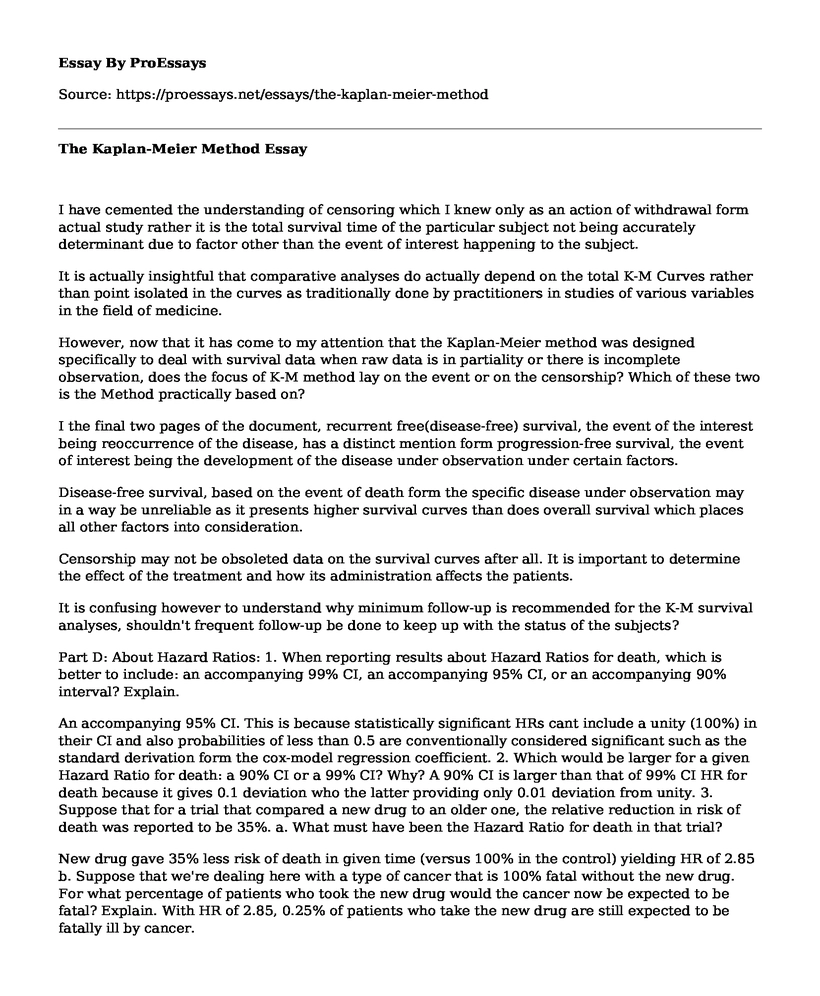I have cemented the understanding of censoring which I knew only as an action of withdrawal form actual study rather it is the total survival time of the particular subject not being accurately determinant due to factor other than the event of interest happening to the subject.
It is actually insightful that comparative analyses do actually depend on the total K-M Curves rather than point isolated in the curves as traditionally done by practitioners in studies of various variables in the field of medicine.
However, now that it has come to my attention that the Kaplan-Meier method was designed specifically to deal with survival data when raw data is in partiality or there is incomplete observation, does the focus of K-M method lay on the event or on the censorship? Which of these two is the Method practically based on?
I the final two pages of the document, recurrent free(disease-free) survival, the event of the interest being reoccurrence of the disease, has a distinct mention form progression-free survival, the event of interest being the development of the disease under observation under certain factors.
Disease-free survival, based on the event of death form the specific disease under observation may in a way be unreliable as it presents higher survival curves than does overall survival which places all other factors into consideration.
Censorship may not be obsoleted data on the survival curves after all. It is important to determine the effect of the treatment and how its administration affects the patients.
It is confusing however to understand why minimum follow-up is recommended for the K-M survival analyses, shouldn't frequent follow-up be done to keep up with the status of the subjects?
Part D: About Hazard Ratios: 1. When reporting results about Hazard Ratios for death, which is better to include: an accompanying 99% CI, an accompanying 95% CI, or an accompanying 90% interval? Explain.
An accompanying 95% CI. This is because statistically significant HRs cant include a unity (100%) in their CI and also probabilities of less than 0.5 are conventionally considered significant such as the standard derivation form the cox-model regression coefficient. 2. Which would be larger for a given Hazard Ratio for death: a 90% CI or a 99% CI? Why? A 90% CI is larger than that of 99% CI HR for death because it gives 0.1 deviation who the latter providing only 0.01 deviation from unity. 3. Suppose that for a trial that compared a new drug to an older one, the relative reduction in risk of death was reported to be 35%. a. What must have been the Hazard Ratio for death in that trial?
New drug gave 35% less risk of death in given time (versus 100% in the control) yielding HR of 2.85 b. Suppose that we're dealing here with a type of cancer that is 100% fatal without the new drug. For what percentage of patients who took the new drug would the cancer now be expected to be fatal? Explain. With HR of 2.85, 0.25% of patients who take the new drug are still expected to be fatally ill by cancer.
The HR reduces the percentage of fatal illness twice more than the previous drug.4. Suppose that three different clinical trials are conducted, each of which compares a different new drug to the same, existing drug, and suppose that the results for the three trials are as follows: Trial for Drug 1: HR for death = 0.80 (95% CI = 0.58 - 1.05) Trial for Drug 2: HR for death = 0.68 (95% CI = 0.28 - 1.12) Trial for Drug 3: HR for death = 0.85 (95% CI = 0.73 - 0.97) a. Which one of the above drugs do you think would have the easiest time gaining FDA approval, all other things being equal? Why?
Drug 1: With an increased potential of survival by HR 0.8, it has a reasonable reduction of risk of early death by cancer compared to the control drug.
b. Which one of the above drugs do you think that patients might be most likely to try first, if given the choice? Why?
Drug 3: With an increased survival rate by HR 0.85, it makes an exponential promise of less risk of early death by cancer compared to control drug.
Cite this page
The Kaplan-Meier Method. (2021, Mar 08). Retrieved from https://proessays.net/essays/the-kaplan-meier-method
If you are the original author of this essay and no longer wish to have it published on the ProEssays website, please click below to request its removal:
- Exercising of Theoretical Nursing Practices on the Actual Field - Paper Example
- Essay Sample on Medicaid Parts and Plans
- How to Take Effective Breaks Essay Example
- Veterans Affairs (VA) Health System Paper Example
- Research Paper on Supply and Demand in Public Health
- Essay on Implementing Respirator Protection Program for Occupational Illness Prevention
- Nurses' Perspectives on Bed Enclosure - Free Article Review







